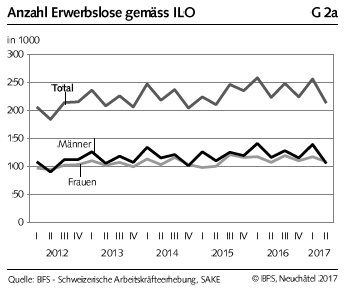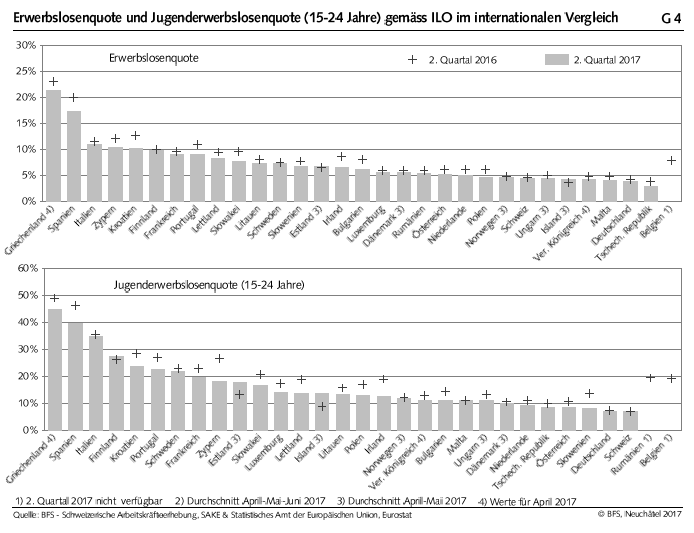Neuchâtel, 17.08.2017 (FSO) – The number of employed persons in Switzerland rose by 1.3% in the 2nd quarter 2017 compared with the same quarter of the previous year. The unemployment rate as defined by the International Labour Organisation (ILO) fell during the same period in Switzerland from 4.6% to 4.4%. The EU’s unemployment rate decreased from 8.6% to 7.6%. These are some of the results from the Swiss Labour Force Survey (SLFS) conducted by the Swiss Federal Statistical Office (FSO) Download press release: Swiss Labour Force Survey in 2nd quarter 2017: labour supply Translated from German: In the second quarter of 2017, Switzerland had a total of 5,015 million employees, 1.3 percent more than in the same quarter
Topics:
Swiss Statistics considers the following as important: Featured, newslettersent, Swiss Macro, Switzerland Unemployment Rate
This could be interesting, too:
Nachrichten Ticker - www.finanzen.ch writes Die Performance der Kryptowährungen in KW 9: Das hat sich bei Bitcoin, Ether & Co. getan
Nachrichten Ticker - www.finanzen.ch writes Wer verbirgt sich hinter der Ethereum-Technologie?
Marc Chandler writes March 2025 Monthly
Mark Thornton writes Is Amazon a Union-Busting Leviathan?
Neuchâtel, 17.08.2017 (FSO) – The number of employed persons in Switzerland rose by 1.3% in the 2nd quarter 2017 compared with the same quarter of the previous year. The unemployment rate as defined by the International Labour Organisation (ILO) fell during the same period in Switzerland from 4.6% to 4.4%. The EU’s unemployment rate decreased from 8.6% to 7.6%. These are some of the results from the Swiss Labour Force Survey (SLFS) conducted by the Swiss Federal Statistical Office (FSO)
Download press release: Swiss Labour Force Survey in 2nd quarter 2017: labour supply
Translated from German:
In the second quarter of 2017, Switzerland had a total of 5,015 million employees, 1.3 percent more than in the same quarter of the previous year. The number of employed men rose by 1.8 per cent, while that of women by 0.6 per cent. In full-time equivalents (FTE), the increase was 1.7% (men: + 1.9%, women: + 1.2%) compared to the same quarter of the previous year. On a seasonal basis, the number of employees and the number of VZÄ increased by 0.6 and 0.5 percent respectively between the first quarter of 2017 and the second quarter of 2017.
Swiss and Foreign WorkersBetween the second quarter of 2016 and the second quarter of 2017, the number of foreign workers rose by 2.6 percent and that of Swiss workers by 0.7 percent. The number of foreigners (ID B or L, + 3.3% for at least 12 months in Switzerland) has risen the most, followed by the workforce with a cross-border commuter permit (ID G: + 3.1% (ID card C: + 1.6%) and the employee with a short residence permit (ID L, less than twelve months in Switzerland: + 0.9%). |
Unemployed According to ILO |
Unemployment in Switzerland and in EuropeIn the second quarter of 2017, 213,000 people were unemployed in Switzerland as defined by the ILO. This is 9000 less than a year earlier. The share of the unemployed in the labor force decreased from 4.6 to 4.4 per cent compared to the second quarter of 2016. On a seasonal basis, the unemployment rate declined slightly from 4.9% to 4.7% compared to the previous quarter. Prior to this, it stood at 4.9 percent between the second quarter of 2016 and the first quarter of 2017. Youth UnemploymentIn Switzerland, the ILO (15 to 24 year olds) youth unemployment rate remained stable at 6.9 percent between the second quarter of 2016 and the second quarter of 2017. In the same period, the unemployment rate in the European Union (EU28: from 18.7% to 16.6%) and in the Eurozone (EZ19: from 21.0% to 18.5%). Unemployment According to Different CharacteristicsThe ILO unemployment rate rose between the second quarter of 2016 and the second quarter of 2017 among the 50- to 64-year-olds (from 3.8% to 4.2%), while the 25- to 49-year-olds declined (From 4.8% to 4.2%). In the case of men, it decreased (from 4.5% to 4.0%), whereas in women it remained unchanged (4.8%). The unemployment rate decreased from 8.3% to 3.1% as well as from foreign nationals (from 8.2% to 7.9%). In the second quarter of 2017 the unemployment rate for the EU28 / EFTA nationals was 5.9 per cent and for third-country nationals 13.0 per cent. Duration of UnemploymentBetween the second quarter of 2016 and the second quarter of 2017, the number of long-term unemployed according to ILO (one year or more unemployed) fell from 91,000 to 83,000 persons. The share of long-term unemployed among all unemployed also decreased; It fell from 40.7% to 39.1%. The median unemployment of unemployment fell from 279 to 242 days. Part-time Work and UnderemploymentThe number of part-time employees in the second quarter of 2017 amounted to 1.704 million (+6000 compared to the same quarter of the previous year). Among them were 350,000 under-employed, that is, People who want to work more and are available in the short term. In the second quarter of 2017, the underemployment rate was 7.2 percent, lower than the second quarter of 2016 (7.5%). |
Unemployment Rate and Youth Unemployment Rate(see more posts on Switzerland Unemployment Rate, ) |
Tags: Featured,newslettersent,Switzerland Unemployment Rate


